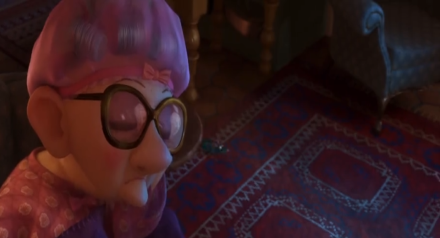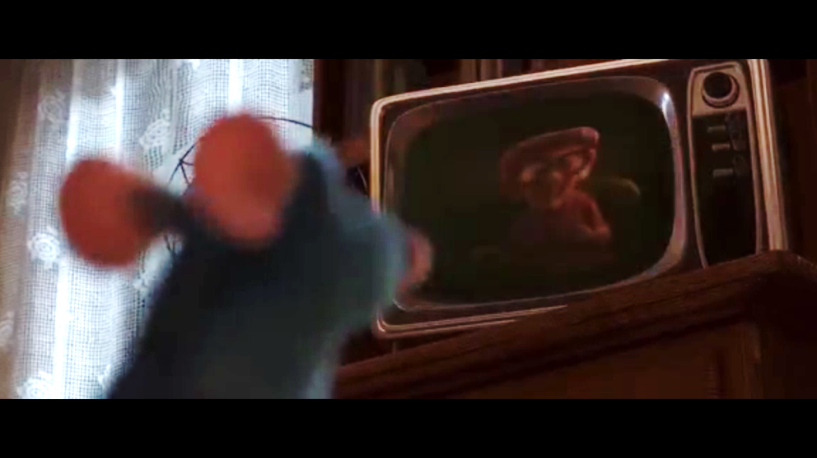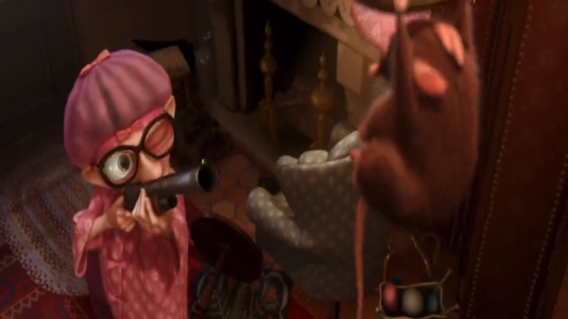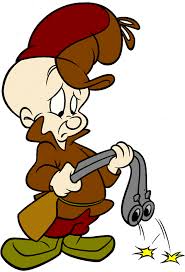Ratatouille’s exploration of human cruelty towards rats is encapsulated in the scene where an old lady discovers that her home is infested by rats.
The old lady is introduced through a static frame that captures her sleeping peacefully whilst highlighting her pink garments, both of which depict her as a stereotypical gentle grandma figure.

Details like this pink cap adorned with bows demonstrate the animator’s
choice to make the old lady appear as harmless as possible to the viewer.
We realise that the old lady has awakened when the programme about Gusteau is replaced by a sinister reflection of her face as she turns off the television. This shot portrays the old lady as an unwanted presence that comes between Remy and his idol Gusteau, which indicates that humans are as troublesome to rats as rats are to humans.

The menacing reflection of the old lady signifies the constant threat
that humans pose to rats.
Our benign expectations of the old lady are further thwarted when we observe her searching for instruments with which to kill the rats. Ratatouille’s extra-diegetic music experiences a crescendo as the rats’ peril increases, reaching its climax when the old lady attains a rifle.


Looney Tunes’ Elmer Fudd, who also hunts animals.
Contrast the image of the old lady sleeping with this frame:
her closed left eye portrays her as an experienced and ruthless poacher.
The above frame shows that appearances can be deceiving since
we cannot make an accurate judgement on this old lady’s character
based on her exterior.
This suggests ironically that we should stop treating rats cruelly
simply because we abhor their appearance.
Here, the music’s low pitch and high volume create a menacing atmosphere which identifies the old lady as a threat to the rats. Initially, we perceive the old lady as vulnerable victim to a rat invasion, yet this extra-diegetic music positions her as villain, and the rats as victims. This subverts the assumption that rats are the aggressors within the human-rat relationship.
Although we are right to condemn the old lady for instinctively reacting to a perceived threat with violence, it is important to remember that one of the reasons that we align ourselves with the rats is because we are privy to dialogue that presents them as thinking, feeling beings.
In this respect, the old lady’s antipathy towards the rats can be explained by the fact that she lacks the privileged insight into their lives that we gain through their dialogue. The old lady only hears Emille squeaking, which informs her perception of him as vermin; whereas we know that he is crying out to Remy for help, which embodies him as an emotional being with the capacity for friendship. This implies that humans only respond to animals with sympathy if they can identify human attributes or behaviours like friendship within them. Ultimately, it is both the old lady’s unjustifiable aggression and the rats’ emotive dialogue that allow us to identify with the rats over the old lady.
Likewise, it is hard for us to identify with the old lady since she is portrayed as less human than the rats through her usage of guttural sounds that portray her as ogre-like. The old lady’s reactive grunting in response to the rats’ utilisation of dialogue to generate proactive escape strategies subverts the theory that humans employ rational thought processes to solve problems, whilst animals merely respond instinctively to stimuli. This implies that access to language does not determine humans as inherently smarter than animals.
Despite the danger that the old lady poses to Remy and the others, the viewer can empathise with her plight when presented with a close-up of her face framed by a dozen rats. The wideness of her eyes conveys her terror, and the preceding static shot showing hundreds of rats facing her indicates that she is outnumbered. Consequently, these two shots evoke the common human fear of rats, which reminds the viewer that many humans would not react rationally to a rat infestation.This represents the way in which humans justify the morality of animal killing by portraying rats as a genuine threat to their safety.

Rat traps and rat poisons are the methods by which we murder rats that we ironically perceive as dangerous to us. These devices allow us to kill rats indirectly, which absolves us from guilt for murdering creatures who mean us no harm.
Regardless of this, the old lady’s use of a gun as a weapon shows that she is the real threat to the human-animal relationship, which encapsulates the film’s developing narrative that treats rats as innocent victims of human antipathy and aggression.
In this respect, Ratatouille is pervaded by the tension between the reality that many humans are fundamentally repulsed by rats, and the fantasy of an animated film that allows us to sympathise with humanised rats like Remy.


The sheer number of rats within this first frame encourages us to see the situation from the old lady’s perspective. She views the rats as a uniform mass rather than as individuals, which explains why she treats them so cruelly.
In the second frame, the old lady’s wide eyes, raised eyebrows and gaping mouth portray her as an innocent victim. This shows that the film’s sympathy fundamentally lies with humans, regardless of the insight it offers into rat perspectives.